The 8 Best Green Teas, According to a Food Writer
Dotdash Meredith and Yahoo Inc. may earn commission or revenue on some items through the links below.
From improving your mood to supporting your gut health, these green teas pack plenty of benefits.
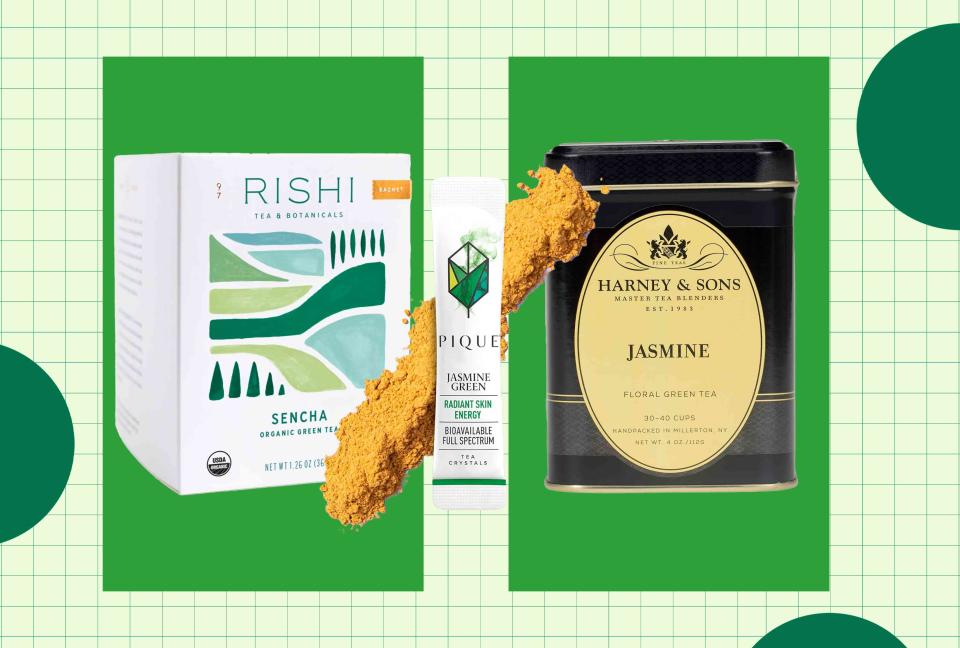
Courtesy of Brand
Reviewed by Dietitian Brierley Horton, M.S., RD
People have consumed green tea for thousands of years, often in the form of a beverage. Whether hot or iced, green tea is known for gentle flavors that range from earthy to sweet. It can also be used as an ingredient in everything from ice cream to cakes to smoothies.
Additionally, green tea is associated with multiple benefits and can help support your heart health, gut microbiome and brain, says Maggie Moon, M.S., RD, brain health nutrition expert for MIND Diet Meals. "As a dietitian specializing in brain health, I’m a fan of green tea for its immediate focus-boosting benefits from caffeine and amino acid L-theanine, and because its polyphenols help pump the brakes on brain aging longer term," Moon says.
We've rounded up our favorite green teas below and detailed what we like (and even dislike) about each one. Through extensive research, we chose our favorite teas in a range of categories, including organic, decaf, matcha and more, to ensure that all sorts of tea drinkers can find the right pick.
Our Green Tea Recommendations
Best Overall: The Republic of Tea Honey Ginseng Green Tea
Best Organic: Buddha Teas Organic Sencha Green Tea
Best Sencha: Rishi Tea Sencha Tea
Best Decaf: Celestial Seasonings Decaf Green Tea
Best Matcha: Encha Ceremonial Grade Organic Matcha Green Tea
Best Loose-Leaf: Harney & Sons Jasmine Tea
Best for Travel: Pique Tea Organic Jasmine Green Tea
Best Bottled: Pure Leaf Unsweetened Green Tea
What Are the Benefits of Green Tea?
Green tea has been linked to various health benefits, including the following:
Blood pressure: Green tea may modestly lower diastolic blood pressure—especially in people with high blood pressure, says Moon. (Diastolic is the second number and it measures the pressure in your arteries when your heart rests between beats.) However, past results have been inconsistent, and overall diet and lifestyle habits will have the greatest impact. “Research suggests that green tea antioxidants protect the blood vessel lining from damage and increase how much of a hormone called adiponectin circulates in the blood, both of which help regulate blood pressure,” Moon says.
Energy: Green tea is a natural source of caffeine, which is a well-established ergogenic aid that improves exercise performance, according to a 2021 study in the Journal of the International Society of Sports Nutrition.
Memory and mood: Green tea is linked to a better mood and improved memory and cognition, according to a study in Phytomedicine. Green tea’s polyphenols have anti-inflammatory properties, and when the overall diet bears a low inflammatory load, the risk of depression decreases by as much as 29 percent, according to a review in Nutrition Reviews. What's more, the polyphenols in green tea are shown to increase brain-derived neurotrophic factor (BDNF), which soothes inflammation and the negative effects of stress on the brain, per a report in Nutrition and Healthy Aging.
Heart health: A wide body of evidence suggests green tea supports heart health, and a 2023 meta-analysis in Frontiers in Nutrition confirms it benefits cholesterol and blood sugar levels.
Gut health: Green tea polyphenols are prebiotics that fuel beneficial gut bacteria and tamp down the growth of harmful bacteria, per a 2021 report in Molecules. “Many of green tea’s benefits may be influenced by its relationship with the gut microbiome,” Moon says.
Best Overall: The Republic of Tea Honey Ginseng Green Tea
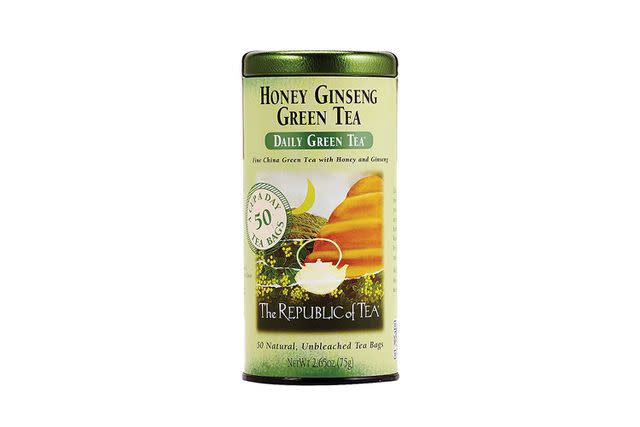
Amazon
What we like: It has a signature flavor that is well-balanced between sweet and nutty.
What to know: It is only sold in bagged form.
If you’re looking for a refreshing, delicate cup of tea that balances sweet and nutty notes, look no further than The Republic of Tea’s People’s Honey Ginseng Green Tea. The tea leaves are sourced from China, where green tea originated, and blended with a few tasty ingredients like Panax ginseng, linden flowers and honey for a signature flavor.
While this tea is only sold in bagged form, the brand offers a very similar blend in loose-leaf form for those who prefer that style. The Honey Ginseng Green Tea is easy to find both in-store and online, typically in a 50-count tin that helps seal in freshness. Extra-thirsty tea lovers can purchase it in a 250-count bulk bag, which is also a more cost-effective option.
Form: Tea bags | Caffeine: 20 to 30 mg | Steep time: 1 to 3 minutes | Ingredients: China green tea, linden flowers, pollen, eleuthero, Panax ginseng, honey flavor
Best Organic: Buddha Teas Organic Sencha Green Tea
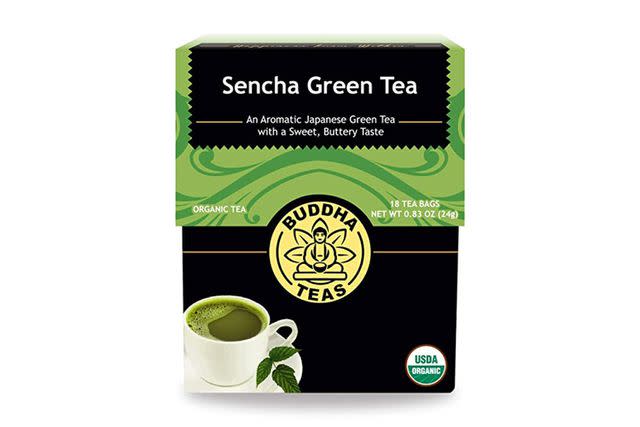
Amazon
What we like: This all-natural tea has no additives or artificial colors, and it comes in bleach-free tea bags.
What to know: The tea bags can tear easily.
There are lots of organic teas out there, but the Buddha Tea Organic Sencha Green Tea earned the spot of our best organic green tea for multiple reasons. The delicate and fresh taste is one of the big ones, of course, but it’s also made without additives or artificial colors—a major plus, in our book. As a bonus, the brand's boxes are made from recycled materials.
Like many organic tea manufacturers, Buddha Teas uses 100 percent organic green tea leaves to create this product. However, the brand takes it a step further by using bleach-free tea bags. This reduces exposure to dioxins, a toxic byproduct of chlorine bleaching that was more of a concern a few decades ago, Moon says.
"These days, exposure to dioxins from bleached tea bags (or coffee filters, for that matter), is very low to nearly unmeasurable due to updated modern processes,” says Moon. “But for anyone who wants to really minimize their exposure, I recommend trying loose-leaf tea or looking for tea bags labeled 'totally chlorine free’ (TCF) or 'elemental chlorine free’ (ECF).”
Form: Tea bags, loose-leaf | Caffeine: 30 mg | Steep time: 3 to 5 minutes | Ingredients: Organic green tea
Best Sencha: Rishi Tea Sencha Tea
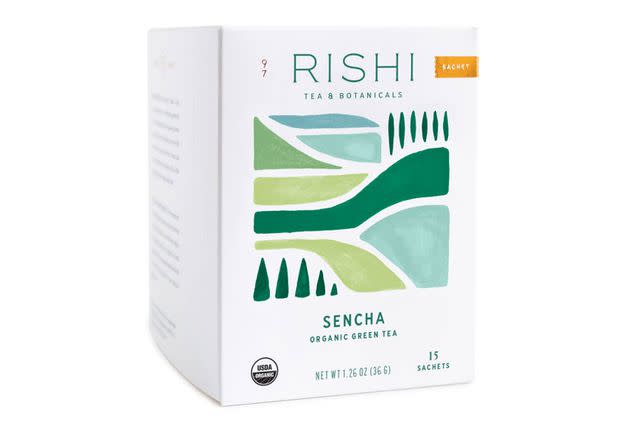
Amazon
What we like: This organic tea has a hearty yet light sweet taste.
What to know: There are only 15 tea bags per box, making it a bit more expensive than others.
Sencha is a Japanese green tea that's easy to identify by its long, thin leaves, and it’s easy to drink throughout the day thanks to its moderate caffeine content. It can contain a range of flavors but typically leans toward the grassier, vegetal side. Rishi Tea's sencha strikes a great balance with a predominantly hearty taste that's underlined by a light sweetness.
The brand sells its sencha in boxes of 15 tea sachets. Rishi includes helpful steeping instructions on its packaging so you can get the most out of the tea. The sencha leaves are organic, non-GMO and sourced on the island of Kyushu in Japan's Kagoshima Prefecture, which boasts a warm and humid climate that allows the tea leaves to develop good flavor.
The price per tea bag is a little pricier than others on our list, but given its flavor and overall quality, we think this Rishi tea is worth the splurge.
Form: Tea bags, loose-leaf | Caffeine: Less than 20 mg | Steep time: 2 minutes | Ingredients: Organic green tea
Best Decaf: Celestial Seasonings Decaf Green Tea
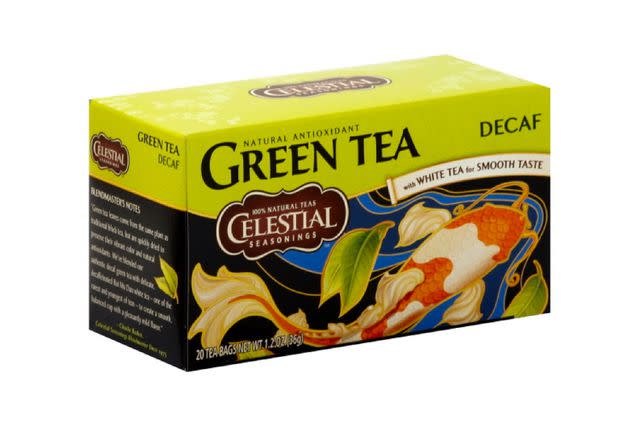
Amazon
What we like: It has no caffeine, and it’s available in both tea bags and K-cups.
What to know: Some might find the flavor to be too mellow.
When it comes to caffeinated beverages, green tea is fairly low on the list. An 8-oz. cup contains on average 25 milligrams of caffeine. For comparison, the same size cup of coffee packs in 95 mg, while black tea hovers around 50 mg. But even though there’s not a lot of caffeine in green tea to start with, you may still be looking for a decaffeinated green tea. That’s where the Celestial Seasonings Decaf Green Tea comes in.
The brand combines green tea and white tea leaves for a smoother, mellower taste. The gentle flavor and lack of caffeine make it a great option right before bed. On the flip side, however, those who prefer a stronger tea may find the beverage to be a bit mild for their tastes.
These tea bags are sold in 40-count boxes, and there's also a K-Cup version available for those who prefer that brewing method.
Form: Tea bags, K-Cups | Caffeine: 0 mg | Steep time: 2 minutes | Ingredients: Decaffeinated green tea, decaffeinated white tea, ascorbic acid (vitamin C)
Best Matcha: Encha Ceremonial Grade Organic Matcha Green Tea
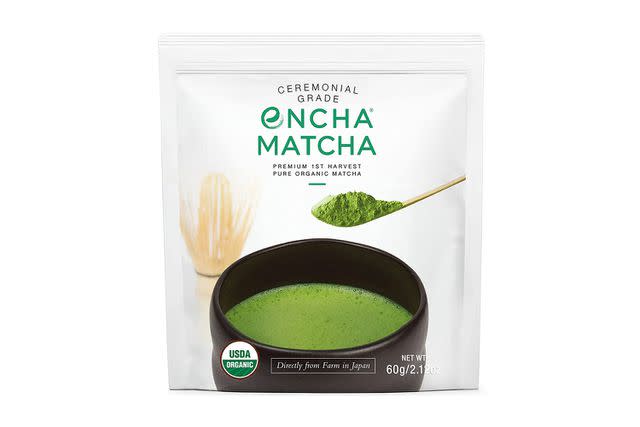
Amazon
What we like: This powdered tea has a mellow, sweet and lightly grassy flavor.
What to know: It’s the most expensive option on our list.
A list of the best green teas wouldn’t be complete without at least one matcha option. Matcha, which literally means “powdered tea,” is a type of green tea that’s made by drying young tea leaves and then grinding them into a fine powder. This process results in a product that's more aromatic and higher in amino acids, caffeine and antioxidants than loose-leaf green tea, Moon says. You can mix the powder with hot water for a traditional matcha or pair it with your favorite milk (or non-dairy milk substitute) for a green tea latte.
Encha’s Ceremonial Grade Organic Matcha Green Tea is mellow and subtly sweet, and it has the light, signature grassy flavor of matcha without being overpowering. It’s also organic and comes directly from Kyoto, Japan—matcha’s birthplace.
The price may make you raise an eyebrow, but keep in mind that a little goes a long way. You only need about 1/2 to 1 teaspoon per cup, so you’ll get 30 to 60 servings from one pouch.
Form: Matcha powder | Caffeine: 60 mg | Steep time: N/A | Ingredients: Pure matcha green tea powder
Related: The 7 Best Matcha Powders, Taste-Tested and Reviewed
Best Loose-Leaf: Harney & Sons Jasmine Tea
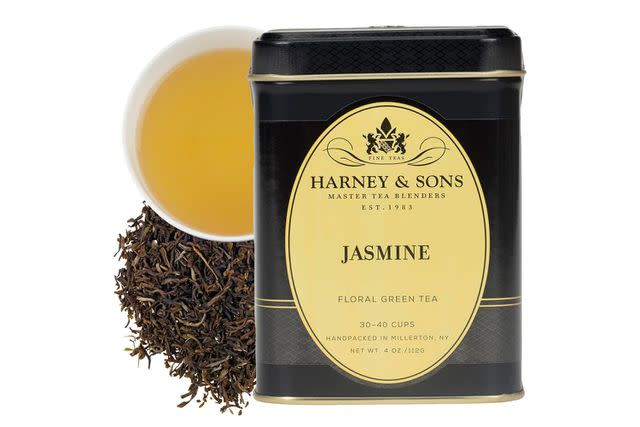
Amazon
What we like: This whole leaf tea has a fragrant jasmine flavor.
What to know: Steeping time is a little longer than other teas.
There are a few reasons why loose-leaf tea usually offers more flavor than bagged tea. First off, loose-leaf tea is composed of fresh, large tea leaves that are typically of better quality than the leaves used in tea bags. Second, there's more room for loose-leaf tea to unfurl and diffuse its flavors into a mug or teapot.
Harney & Sons has a range of loose-leaf green teas, including this delightful jasmine variety. It's quite fragrant, thanks in part to the jasmine flowers that are mixed in with the green tea leaves. Like most jasmine teas, the flavor is on the gentler side. Expect to taste a light bitterness and grassiness underneath the floral aroma.
This tea is available in a 1-pound bag or 4-oz. tin; the brand also sells a sampler if you want to try a cup before committing to an entire package. Tea bags and tea sachets are available, too. Harney & Sons recommends steeping the tea for 5 minutes (which is a little longer than other teas on this list) at 212°F.
Form: Loose-leaf, sachets | Caffeine: Not specified | Steep time: 5 minutes | Ingredients: Green tea, jasmine flowers
Best for Travel: Pique Tea Organic Jasmine Green Tea
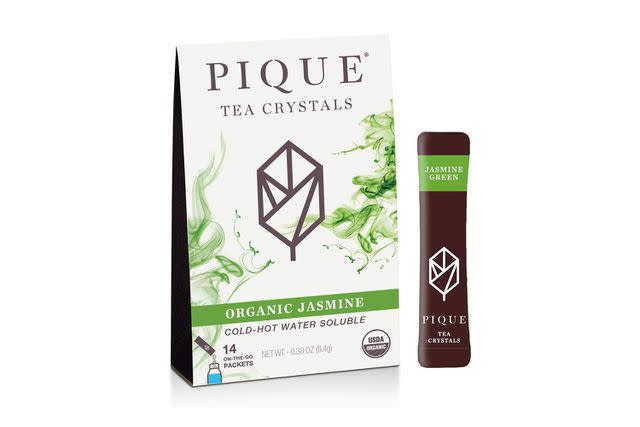
Amazon
What we like: These tea crystals come in packets, which are convenient for anyone on the go.
What to know: Some may find it to have a bitter taste.
Pique is an innovator in the tea world, creating travel-friendly tea crystals that are soluble in water. Each box of Organic Jasmine Green Tea contains 14 individual packets that you can mix with either hot or cold water. Stir the crystals into hot water for a cozy cup, or pour them right into bottled water and shake for iced tea.
So, what exactly are tea crystals? Pique's unique innovation takes loose-leaf tea and brews it in low-temperature water for 8 hours until it becomes a fast-dissolving powder. The brand says its gentle extraction process creates a sort of tea concentrate that preserves up to 12 times more antioxidants than comparable tea brands. The Organic Jasmine Green Tea is not only convenient, but it also has a fresh flavor that makes each sip smooth and enjoyable.
Form: Tea crystals | Caffeine: 22 to 33 mg | Steep time: N/A | Ingredients: Organic green tea, spearmint
Best Bottled: Pure Leaf Unsweetened Green Tea
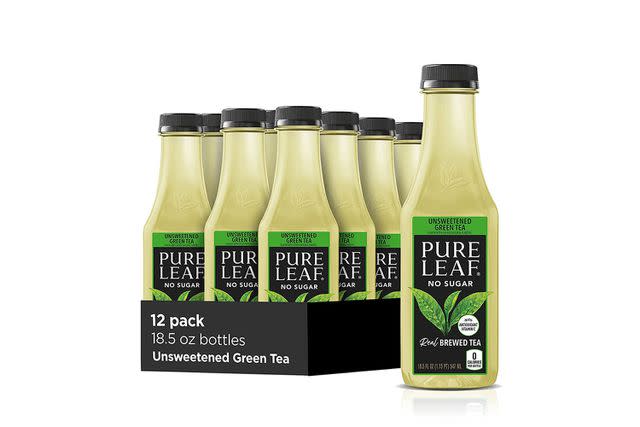
Amazon
What we like: This premade tea is cool, refreshing and made with only three ingredients.
What to know: Some find the taste changes with different batches.
Many pre-bottled iced teas can be full of sugar or artificial sweeteners, but the Pure Leaf Unsweetened Green Tea isn’t like most. Not only is it completely free of sugar, but it’s made with only three ingredients: Brewed green tea, ascorbic acid (vitamin C) and natural flavor.
This tea is brewed from fresh tea leaves that are picked at their prime. Since there are no powders or concentrates used here, the simplicity gives it a crisp, clean flavor that tastes just like freshly brewed tea that you’d make at home.
The bottles come in three sizes—18.5-oz., 59-oz. and 64-oz.—so you can take this tea with you on the go or keep it stocked in your refrigerator.
Form: Bottled iced tea | Caffeine: 44 mg | Steep time: N/A | Ingredients: Brewed tea, ascorbic acid, natural flavor
The Bottom Line: The Best Green Teas
The Republic of Tea's People's Honey Ginseng Green Tea (view at Amazon) has everything you could want: It's affordable, easy to find in stores and online and offers a balance of sweet and earthy flavors. Additionally, you can enjoy it either hot or iced. If you’re interested in a loose-leaf option, we love the fragrant Harney & Sons Jasmine Tea (view at Amazon).
Choosing a Green Tea
Consider the Variety
Whether you're new to green tea or a seasoned sipper, knowing a bit about the different varieties will make it easier to choose the right option:
Sencha: perhaps the most common variety and a great starting point for beginners
Matcha: another popular option. Matcha is made from specially cultivated young green tea leaves (called tencha) that are ground into a fine powder.
Hōjicha: Roasted Japanese green tea
Genmaicha: Green tea leaves mixed with roasted brown rice
Gyokuro: A high-end (and often expensive) shade-grown Japanese green tea
Longjing: Made of roasted green tea sprouts grown in the Longjing village of Hangzhou, China
Biluochun: A delicate green tea variety grown in the Dongting mountain region of China
Pick the Right Blend
Any green tea that's paired with additional ingredients is considered a blend. Many fruits, flowers and herbs mix well with green tea, and you'll often find these items incorporated into green tea blends. Green tea is usually gentle enough that it takes on a lot of the added flavors—mint is one of the most common examples—so check to see if you like the other ingredients in a green tea blend before buying.
If you don't love the taste of green tea, or if you're new to it, try starting with a blend that contains another type of tea. Many green tea blends include herbal teas that have a milder flavor and, sometimes, less caffeine.
Look At the Packaging
It may seem minor, but the way your tea is packaged affects how it’s brewed and, subsequently, how it tastes. You'll likely see tea packaged in one of three ways: tea bags, sachets or loose-leaf. If you prefer quickness and convenience, tea bags are the way to go. If you want to adjust tea strength to your specific taste, try loose-leaf. Sachets strike the middle ground, storing loose tea in large, usually pyramid-shaped bags.
Factor In the Price
Like all kinds of tea, green tea comes in a wide variety of prices. In our list alone, prices range from under $5 to upwards of $30 per package. You can pick up affordable bagged options in your local grocery store or find pricey loose-leaf varieties online or at specialty tea shops. Generally, you get what you pay for as far as quality—but luckily, there are good options in practically every price range.
Common Questions
How much caffeine is in green tea?
The amount of caffeine in green tea varies widely, just like it does with all types of tea. Everything from where the tea is harvested to the way it's prepared affects the caffeine content. On average, an 8-oz. cup of green tea contains roughly 25 mg of caffeine, but it can range anywhere from 12 to 75 mg. This is a relatively low amount, less than that of black and oolong tea. One quick way to gauge the amount of caffeine in a cup of tea is to focus on its bitterness. “Caffeine is bitter, so you can assume that the more bitter the tea, the more caffeine you're taking out of the leaves,” says Shunan Teng, founder and CEO of Tea Drunk.
Will drinking green tea help me lose weight?
The bioactive compounds in green tea are known to provide a modest boost in metabolism and to help burn fat on a cellular level, especially in combination with exercise, per a 2023 study in the International Journal of Food Sciences and Nutrition. Observational studies suggest drinking tea every day helps reduce body fat, and experimental studies support this finding by showing green tea can increase calories burned, break down fat and dampen the formation of new fat cells.
However, the effects in terms of real-world weight loss are modest, Moon says. “If weight loss is important to improving your health, I’d advise you to consider green tea in the context of a lifestyle medicine plan that includes a healthy balanced diet, physical activity, stress reduction and quality sleep,” Moon says.
Does green tea help with bloating?
Green tea’s antioxidants can help calm inflammation that can lead to bloating, Moon says. But on a more basic level, green tea is a vehicle for hydration, which can help relieve constipation-related bloating. "Staying hydrated helps soften stool so it passes easily; otherwise, the body will steal water from food in the gut as it goes through, making hard stool linger and ferment longer, producing gas and bloating," Moon says.
Does green tea cause kidney stones?
Some people who worry about kidney stones may try to avoid green tea because it contains oxalate, which binds with calcium to form kidney stones, Moon says. However, 2019 research in the International Journal of Urology of more than 2,600 adults with a history of kidney stones suggests drinking green tea won’t increase the risk of kidney stones—in fact, it may even help reduce the risk of stone formation. Previous research suggests green tea may also reduce the risk for people without a history of kidney stones.
“People who want to enjoy green tea with fewer oxalates can add milk, though this also lowers its antioxidants,” Moon says. “Steeping for no more than five minutes, which is the recommended time, will also reduce the amount of oxalates in the cup.”
How do you make green tea?
Green tea is one of the gentlest tea varieties, so it’s best to use cooler water and steep for a shorter amount of time than you would with other teas. Teng recommends starting with water that’s around 176°F to 194°F and steeping for about two minutes, then adjusting time and temperature based on your preferences. The recommended ratio, called the “golden ratio,” is 2 g of tea for every 8 oz. of water. “This is a good starting point,” Teng says, “and you can make adjustments from there.”
One key brewing tip she gives is to steep your tea in an open vessel. If you’re using a teapot, for instance, leave the lid off while the tea steeps. “When you cover tea, you can overcook it and damage the flavor,” says Teng.
How do you make iced green tea?
There are two ways to make iced tea. The first is to steep tea leaves or tea bags in hot water and add ice afterward. This takes about 10 to 20 minutes. The second method is “cold brewing,” where you steep tea in cold water for a longer period of time, usually overnight.
For hot-brewed iced tea, start by heating 4 cups of water to your desired temperature—but keep in mind that you don’t want a fully rolling boil for green tea. Steep four tea bags, or 4 tablespoons of loose-leaf tea, for around 5 minutes, then remove the tea bags or strain the loose leaves. After that, add 4 cups of cold water to dilute the concentrated tea. Finally, refrigerate until it's chilled, or add ice and serve right away.
For cold-brewed iced tea, Teng recommends a ratio of 6 g of loose-leaf tea for every 25 oz. of water, or roughly 15 g of tea for an 8-cup pitcher. After adding the tea to the water, you’ll simply leave the mixture in the fridge for 36 to 48 hours. “Cold brew is super simple,” Teng says. “It’s a foolproof and very forgiving method.” Since it's unpasteurized, though, it’s best to drink cold-brewed iced tea very soon after the 48-hour brewing window has elapsed. If you leave it any longer than three days, the microorganisms in the tea may pose a health risk.
Is matcha a type of green tea?
Yes, matcha is a type of green tea. There are a couple of ways in which it's different from other green teas, though. First, matcha comes in powder form because it's made of ground-up tea leaves; other green teas usually have larger, fuller leaves. Second, matcha is meant to be mixed with hot water so that you actually ingest the leaves when you drink it. This differs from the majority of other teas, where the leaves are strained out of the water and not ingested.
Our Trusted Expertise
Lindsay Boyers is a certified holistic nutritionist with extensive food and drink testing experience. She’s developed over 1,000 original recipes and is constantly on a mission to find the best options across all food and beverage categories. For this piece, she consulted with Shunan Teng, the founder and CEO of Tea Drunk and an avid tea educator. Tea Drunk was founded in 2013 and has a brick-and-mortar tea house in New York City. Its teaware and Chinese teas can be purchased online.
This piece was updated by Derek Rose, the coffee and tea expert for The Spruce Eats. He researches a variety of products, from tiny tea infusers to high-end kettles, and interviews field experts for their insight. He is especially a fan of matcha, enjoying it in everything from lattes and smoothies to the traditional form.
Additional reporting was provided by April Benshosan, M.S., who consulted with Maggie Moon, M.S., RD, brain health nutrition expert for MIND Diet Meals, for her insights on green tea and its benefits.
Read the original article on Eating Well.

